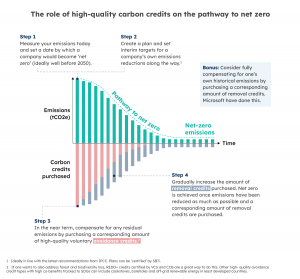The year has reached its finale and the curtain is soon to close. But before we can clap our hands in applause, it’s important to reflect on 2022.
It is widely agreed that we must achieve net zero emissions by 2050. This requires substantial action to be taken now to cut currently unavoidable emissions1. As we discussed in our 2022 White Paper, such a transition requires finance at scale yet there is currently a significant gap between what is delivered and what is necessary to reach net zero. However, there are solutions – the voluntary carbon market provides an effective tool to channel private capital to climate mitigation projects.
This fact is increasingly recognised by corporates around the globe. Indeed, at the start of the year, South Pole reported that voluntary carbon markets were experiencing a period of expansion – both in terms of demand and innovation. Having observed a rise in prices and a tightening of quality standards, the market trajectory was positive. Twelve months on, we have an opportunity to reflect. How has the year played out for the voluntary carbon market? And what successes can we celebrate as we move into 2023?
First, think global
The voluntary carbon market has been operating within a challenging global context this year. Russia’s invasion of Ukraine has created a dire humanitarian crisis and threatened the energy security of much of Europe. This instability has exacerbated an already-precarious economic situation as we gradually re-establish ourselves after the covid-19 pandemic. For many, the world has been hard to navigate in 2022 and we continue to stand in solidarity with all those affected.
While this is likely to have some short term impacts for the voluntary carbon market, in the medium to long term the market is expected to be resilient to price declines2. As our CEO, Ana Haurie, writes for Carbon Pulse, ‘the climate has not changed’ and as a result, more and more corporates and financial institutions are making ambitious net zero pledges.
Our thoughts are also with the communities hit by catastrophic climate events this year. Pakistan battled an extreme and deadly flood; Florida was hit by Hurricane Ian – the most destructive since 1935 – and Europe saw temperatures soaring beyond 40 degrees in an intense summer heatwave. These are not ‘fluke’ events; their frequency has been increased by global climate change which yet again emphasises the severity of the environmental crisis we face.
It wasn’t only global events that reminded us of the pressing need for climate mitigation in 2022. The release of the third instalment of the IPCC’s Sixth Assessment report also highlighted the urgency with which we must act3. Delivering a frank review of current mitigation efforts, the report stated that the window for securing a liveable future is rapidly closing. Presented with such unequivocal evidence, governments and corporations are waking up. This year has shown an increasing understanding that rapid decarbonisation is required without delay.
Rising need, rising prices
The need for corporate action is clear and never before has it been acknowledged so extensively. In its November report, the UN’s High Level Expert Group backed the voluntary carbon market, stating that:
“High integrity carbon credits in voluntary markets should be used for beyond value chain mitigation.”
Furtherstill, following a historic 2021 in which market transactions exceeded $2 billion, Ecosystem Marketplace observed that the future of the voluntary carbon market has ‘never looked brighter’. It may well be right. The near quadrupling of value observed since 2020 presents an optimistic picture for upcoming demand4. South Pole attributed this rising demand to more companies investing in sustained, long-term carbon strategies in place of one-off credit purchases. Moreover, increasing value initiates a positive feedback loop in which rising credit prices enable more ambitious carbon projects to be developed. These projects in turn serve to drive prices higher.
Yet demand was not equal across all credit types in 2022. One of the largest surges was seen for credits generated from nature-based projects5, highlighting a growing recognition of the need for nature in our fight against climate change.
The need for nature
Nature was christened as the climate’s secret ally by WWF this year. Its report drew out aspects of the IPCC’s Sixth Assessment to reveal exactly how critical conservation and restoration are for our collective futures. In the last 10 years, 54% of man-made emissions have been absorbed by land or ocean-based ecosystems6. Demonstrably slowing global warming, nature is vital to combat climate change and has huge potential to provide up to one third of the climate mitigation required by 20307.
To tap into this potential, conservation is vital. In June, Global Canopy reported that reaching net zero requires a complete halt on deforestation8 by 2025. Cutting trees not only reduces the capacity of forests to absorb carbon, but also releases additional emissions into the atmosphere. Unless this can be stopped, the report iterated that we cannot reach net zero by 2050.
The need for nature was also articulated by McKinsey in its report on blue carbon9. It discussed how coastal ecosystems such as mangroves and seagrass meadows are under intense pressure, but can act as highly effective carbon sinks. The report shared the established and emerging techniques for conserving and restoring these ecosystems as part of a wider climate mitigation strategy.
Both forests and blue carbon were discussed in the World Resources Institute’s 2022 report. It offered guidance on the responsible use of these nature-based solutions until 2040, warning that nature-based projects can only support the Paris Agreement if implemented with integrity. For project developers, this means respecting and advocating for the land rights of Indigenous Peoples and Local Communities while conserving biodiversity. For buyers, this means reducing emissions across their own value chains before counterbalancing with nature-based credits10.
It’s all about quality and integrity
This year has seen a concerted effort made to drive quality and integrity across the voluntary carbon market. The ICVCM’s Draft Core Carbon Principles were released in draft form in July. Intended to provide quality assurance, the principles will assess credits based on additionality, methodology and permanence to determine if they exceed a minimum ‘high quality’ threshold. Moreover, the principles will work to ensure that credits align with the Paris Agreement, meaning that emission reductions cannot be claimed by multiple parties11.
In June, the VCMI published its Provisional Claims Code of Practice for non-state actors. It outlined the criteria for credible carbon use to meet net zero targets. The code detailed that companies must set science-based interim targets to reduce emissions before turning to the voluntary carbon market12. Furthermore, when credits are purchased, the code specifies that they must be high quality. It clarifies what constitutes high quality, stating that credits must be recognised by an independent verification body; have genuine measures in place to ensure permanence and, where relevant, be entirely compatible with human rights.
In the release of its new draft guidance, WBCSD recognised that identifying high quality can be a challenge for buyers, especially those new to the voluntary carbon market. Specifically focused on natural climate solutions, it is set to publish a buyer’s guide following feedback received this winter. Highly relevant to anyone seeking to purchase credits, the guide will outline methodologies, verification and existing standards13.
Yet whatever the methodology, one thing remains clear: the use of carbon credits must accompany a deep and sustained decarbonisation across corporate value chains if we are to keep 1.5 alive14. Indeed, on this path to net zero, the consensus is still to start with nature-based solutions as these projects are available now. Whatever technologies are approved going forward, it is vital that we prioritise the protection, management and restoration of our ecosystems on the pathway to net zero.

Step by step: Progress on Article 6
For many of us, the latter part of 2022 was defined for many by COP27. With Article 6 scheduled as a key point of discussion, stakeholders across the voluntary carbon market were highly invested in conference outcomes.
COP27 achieved clarification on the Clean Development Mechanism transition and, in a historic moment, the first international trade under Article 6.2 was authorised between Ghana and Switzerland15. However, the rules surrounding corresponding adjustments were not finalised. While it seems as if corresponding adjustments will not be necessary for voluntary transactions for the time being, the claims able to be made based on non-authorised credits are likely to change. Moreover, no specific agreement was reached on whether an authorisation of corresponding adjustments can be revoked.
However technical, it is undeniable that progress was made on Article 6 at COP27 but there is still more work to be done. We will be eagerly watching to see how countries will react to these developments throughout 2023.
Working with local communities
Throughout 2022, the world became increasingly aware that without championing the knowledge of Indigenous Peoples and Local Communities (IPLCs), we are tackling the climate crisis with one hand tied behind our backs. The Forest Declaration Assessment stated that we will not achieve our nationally determined contributions set at Paris without the active involvement of IPLCs. Although the report found that IPLC lands sequester, on average, twice the volume of carbon as non-indigenous lands, it also warned government frameworks fall short of what is required to sufficiently make use of this potential16.
On this front, insecure land rights pose a significant barrier. Isack Bryson, Project Manager at Carbon Tanzania, recently covered this issue in an opinion piece for Newsweek. As a matter of priority, he called for land rights to be discussed at COP15, stating that land rights must be secured if we are to ‘protect forests and an indigenous way of life’. He cited carbon finance as a tool to make this happen, advocating that projects should actively engage people on the ground to raise awareness of the benefits this funding can bring. Indeed, throughout 2022, carbon finance has been increasingly recognised as a tool to channel funding in support of IPLCs and – as we move into 2023 – is a trend we would like to see continue.
5 https://www.southpole.com/de/publikationen/the-voluntary-carbon-market-eight-things-to-know-for-the-year-ahead
7 https://www.wbcsd.org/Programs/Climate-and-Energy/Climate/Natural-Climate-Solutions#:~:text=As%20a%20subset%20of%20Nature,1.5%C2%B0C%20by%202030.
8 https://globalcanopy.org/wp-content/uploads/2022/06/Why-net-zero-needs-zero-deforestation-now-June-2022.pdf
9 https://www.mckinsey.com/capabilities/sustainability/our-insights/Blue-carbon-The-potential-of-coastal-and-oceanic-climate-action
10 https://www.wri.org/insights/guidance-voluntary-use-nature-based-solution-carbon-credits-through-2040
13 https://www.wbcsd.org/Programs/Climate-and-Energy/Climate/Natural-Climate-Solutions/The-Natural-Climate-Solutions-Alliance/Resources/A-Buyer-s-Guide-to-Natural-Climate-Solutions-Carbon-Credits-Draft-for-comment





